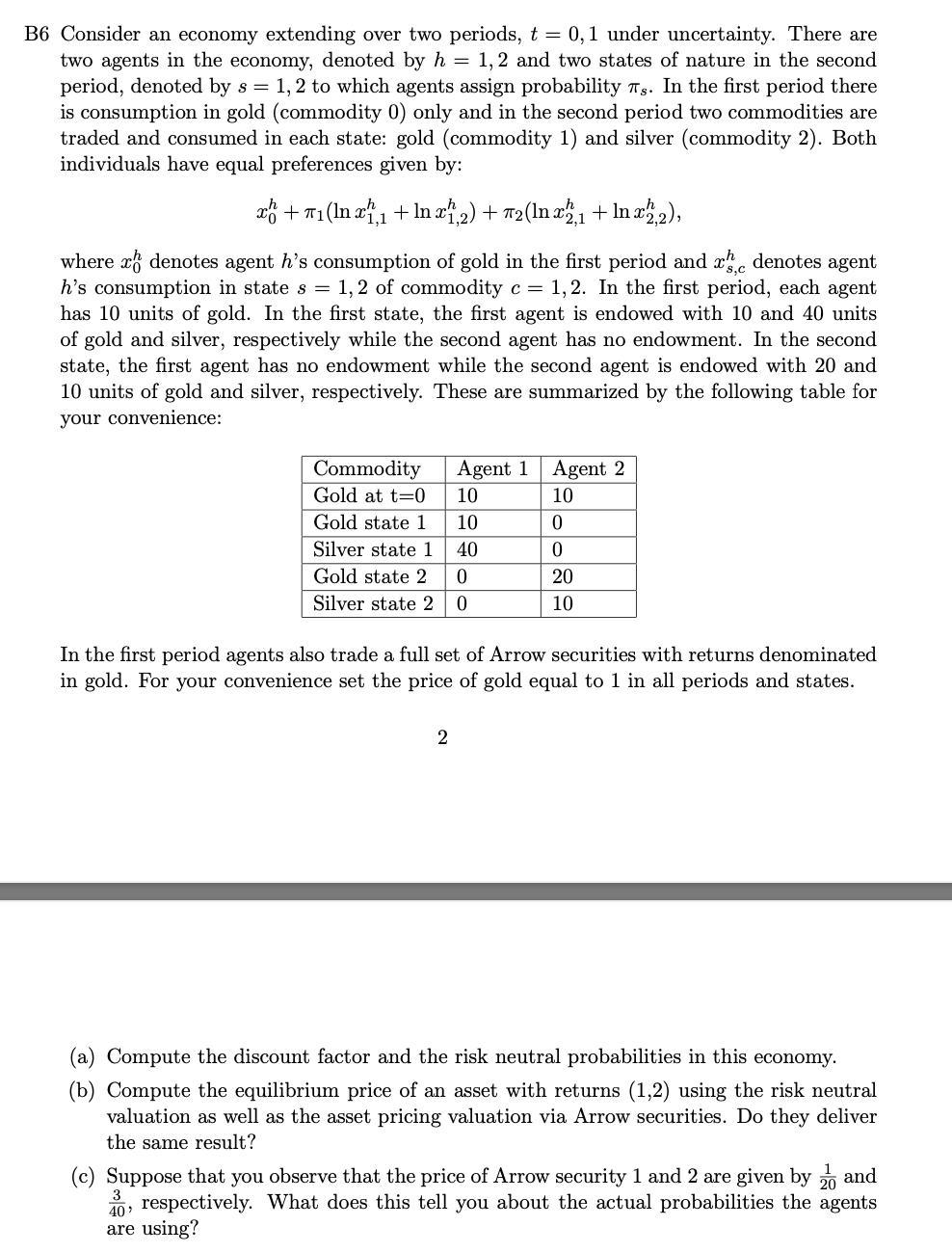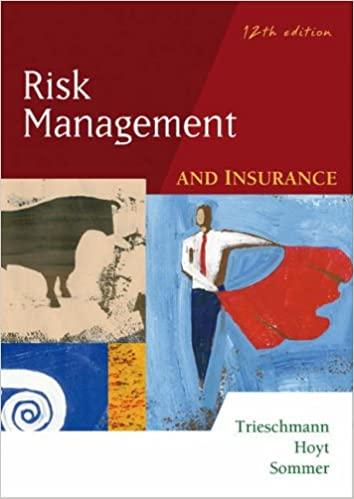Question
B6 Consider an economy extending over two periods, t = 0, 1 under uncertainty. There are two agents in the economy, denoted by h =

B6 Consider an economy extending over two periods, t = 0, 1 under uncertainty. There are two agents in the economy, denoted by h = 1, 2 and two states of nature in the second period, denoted by s = 1, 2 to which agents assign probability s. In the first period there is consumption in gold (commodity 0) only and in the second period two commodities are traded and consumed in each state: gold (commodity 1) and silver (commodity 2). Both individuals have equal preferences given by:
xh0 + 1(ln xh1,1 + ln xh1,2) + 2(ln xh2,1 + ln xh2,2),
where xh0 denotes agent hs consumption of gold in the first period and xhs,c denotes agent hs consumption in state s = 1, 2 of commodity c = 1, 2. In the first period, each agent has 10 units of gold. In the first state, the first agent is endowed with 10 and 40 units of gold and silver, respectively while the second agent has no endowment. In the second state, the first agent has no endowment while the second agent is endowed with 20 and 10 units of gold and silver, respectively. These are summarized by the following table for your convenience:
B6 Consider an economy extending over two periods, t = 0,1 under uncertainty. There are two agents in the economy, denoted by h = 1, 2 and two states of nature in the second period, denoted by s = 1,2 to which agents assign probability as. In the first period there is consumption in gold (commodity 0) only and in the second period two commodities are traded and consumed in each state: gold (commodity 1) and silver (commodity 2). Both individuals have equal preferences given by: to + r1(In 21,1 + In x2) + T2(In x, 1 + ln x,2), where xdenotes agent hs consumption of gold in the first period and xs,c denotes agent h's consumption in state s = 1, 2 of commodity c= 1,2. In the first period, each agent has 10 units of gold. In the first state, the first agent is endowed with 10 and 40 units of gold and silver, respectively while the second agent has no endowment. In the second state, the first agent has no endowment while the second agent is endowed with 20 and 10 units of gold and silver, respectively. These are summarized by the following table for your convenience: Agent 1 10 Agent 2 10 0 Commodity Gold at t=0 Gold state 1 Silver state 1 Gold state 2 Silver state 2 10 40 0 0 20 10 0 In the first period agents also trade a full set of Arrow securities with returns denominated in gold. For your convenience set the price of gold equal to 1 in all periods and states. 2 (a) Compute the discount factor and the risk neutral probabilities in this economy. (b) Compute the equilibrium price of an asset with returns (1,2) using the risk neutral valuation as well as the asset pricing valuation via Arrow securities. Do they deliver the same result? (c) Suppose that you observe that the price of Arrow security 1 and 2 are given by 2 and respectively. What does this tell you about the actual probabilities the agents are using? 40 B6 Consider an economy extending over two periods, t = 0,1 under uncertainty. There are two agents in the economy, denoted by h = 1, 2 and two states of nature in the second period, denoted by s = 1,2 to which agents assign probability as. In the first period there is consumption in gold (commodity 0) only and in the second period two commodities are traded and consumed in each state: gold (commodity 1) and silver (commodity 2). Both individuals have equal preferences given by: to + r1(In 21,1 + In x2) + T2(In x, 1 + ln x,2), where xdenotes agent hs consumption of gold in the first period and xs,c denotes agent h's consumption in state s = 1, 2 of commodity c= 1,2. In the first period, each agent has 10 units of gold. In the first state, the first agent is endowed with 10 and 40 units of gold and silver, respectively while the second agent has no endowment. In the second state, the first agent has no endowment while the second agent is endowed with 20 and 10 units of gold and silver, respectively. These are summarized by the following table for your convenience: Agent 1 10 Agent 2 10 0 Commodity Gold at t=0 Gold state 1 Silver state 1 Gold state 2 Silver state 2 10 40 0 0 20 10 0 In the first period agents also trade a full set of Arrow securities with returns denominated in gold. For your convenience set the price of gold equal to 1 in all periods and states. 2 (a) Compute the discount factor and the risk neutral probabilities in this economy. (b) Compute the equilibrium price of an asset with returns (1,2) using the risk neutral valuation as well as the asset pricing valuation via Arrow securities. Do they deliver the same result? (c) Suppose that you observe that the price of Arrow security 1 and 2 are given by 2 and respectively. What does this tell you about the actual probabilities the agents are using? 40Step by Step Solution
There are 3 Steps involved in it
Step: 1

Get Instant Access to Expert-Tailored Solutions
See step-by-step solutions with expert insights and AI powered tools for academic success
Step: 2

Step: 3

Ace Your Homework with AI
Get the answers you need in no time with our AI-driven, step-by-step assistance
Get Started


